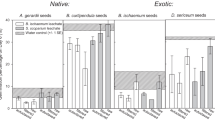Abstract
Failure of natural regeneration of conifers, such as subalpine spruce (Picea abies) and black spruce (Picea mariana), has been reported in the presence of dominant ericaceous understory plants of boreal forests of North America, Fino-Scandinavia, and northern Europe. Among other factors such as competition for light and nutrients, conifer regeneration failure has been attributed to allelopathic effects of the understory ericaceous plants. Rabotnov theorized that (the manifestation of) allelopathy is a result of long-term coevolution within established plant communities and that it may have maximum inhibitory effects on introduced species. Our objectives were to determine what components of the understory ericaceous plant, Vaccinium myrtillus, affect spruce regeneration and to test Rabotnov's hypothesis. Field experiments were complemented with laboratory studies in which seed germination and primary growth of the two spruces were used as response variables. We found that P. mariana was generally more affected than P. abies by V. myrtillus allelochemicals, both in field and in vitro experiments. Field germination of P. abies was only 2% and 3% in the undisturbed sowed plots and in Vaccinium-removed sowed plots, respectively, but P. marana did not germinate at all in these treatments. In humus-removed sowed plots, P. abies had 27% germination, while P. marian had only 15%. In a controlled experiment, P. mariana had the highest decrease in dry weight of primary root in the fresh leaf treatment of V. myrtillus (77%), followed by its leaf leachate (71%), humus (29%), and humus leachate (13%). The decreases in root dry weights of P. abies due to these treatments were 67, 47, 30, and 10%, respectively. Our results provide support for Rabotnov's hypothesis. It is possible that both V. myrtillus and Kalmia angustifolia, involved in the growth inhibition process of P. abies and P. mariana, respectively adopted similar "strategies" of allelopathic inhibition of conifers, by allocating a large part of their carbon pool to the production of secondary metabolites.
Similar content being viewed by others
REFERENCES
AndrĚ, J., Gensac, P., Pellissier, F., and Trosset, L. 1987. Régénération des peuplements d'épicéa en altitude: recherches préliminaires sur le rôle de l'allélopathie et de la mycorhization dans les premiers stades du développement. Rev. Ecol. Biol. Sol. 24:301–310.
Camaret, S. 1997. Rôle des Perturbations dans la Dynamique des Pessiéres d'Altitude. PhD thesis. University of Savoie, France, 264 pp.
Gallet, C., and Pellissier, F. 1997. Phenolic compounds in natural solutions of a coniferous forest. J. Chem. Ecol. 23:2401–2412.
JÄderlund, A., Zackrisson, O., and Nilsson, M. C. 1996. Effects of bilberry (Vaccinium myrtillus L.) litter on seeds germination and early seedling growth of four boreal tree species. J. Chem. Ecol. 22:973–986.
Mallik, A. U. 1987. Allelopathic potential of Kalmia angustifolia to black spruce (Picea mariana). For. Ecol. Manage. 20:43–51.
Mallik, A. U. 1992. Possible role of allelopathy in growth inhibition of softwood seedlings in Newfoundland, pp. 321–340, in S. J. H. Rizvi, and V. Rizvi (eds.). Allelopathy: Basic and Applied Aspects. Chapman & Hall, London.
Mallik, A. U., and Roberts, B. A. 1994. Natural regeneration of Pinus resinosa on burned and unburned sites in Newfoundland. J. Veg. Sci. 5:179–186.
Nilsson, M. C. 1994. Separation of allelopathy and resource competition by the boreal dwarf shrub Empetrum hermaphroditum Hagerup. Oecology 98:1–7.
Pellissier, F. 1992. Reboisement expérimental dans une pessiére subalpine à régénération naturelle déficiente. Rev. For. Fr. 44:54–61.
Pellissier, F. 1993. Allelopathic inhibition of spurce germination. Acta Oecol. 14:211–218.
Pellissier, F. 1994. Effect of phenolic compounds in humus on the natural regeneration of spruce. Phytochemistry 36:865–867.
Pellissier, F. 1998. The role of soil community in plant population dynamics: Is allelopathy a key component? Trends Ecol. Evol. 13:407–408.
Pellissier, F., and Trosset, L. 1992. Les difficultés de régénération naturelle des pessiéres subalpines: Prédation des graines au sol et blocages dus à l'humus. Ann. Sci. For. 49:383–388.
Ponge, J. F., Andre, J., Bernier, N., and Gallet, C. 1994. La régénération naturelle: Connaissances actuelles. Le cas de l'épicéa en forêt de Mâcot (Savoie). Rev. For. Fr. 46:25–45.
Rabotnov, T. A. 1977. The significance of the coevolution of organisms for the formation of phytocoenoses. Bull. M.O.I.P. Otd. Biol. 82:91–102. (in Russian).
Rabotnov, T. A. 1978. On the importance of the pyrogenic factor for the formation of the plant cover. Bot. Zh. (Leningr.) 63:1605.
Rabotnov, T. A. 1982. Importance of the evolutionary approach to the study of allelopathy. Sov. J. Ecol. 12:127–130.
Rice, E. L. 1984. Allelopathy. Academic Press, Orlando, Florida.
Souto, X. C., Chiapusio, G., and Pellissier, F. 1998. Soil microorganisms and phenolics: Their implication in natural forest regeneration, pp. 301–308, in K. Sassa, (ed.). Environmental Forest Science. Kluwer Academic Publishers, London.
Thompson, I. D., and Mallik, A. U. 1989. Moose browsing and allelopathic effects of Kalmia angustifolia on balsam fir regeneration in central Newfoundland. Can. J. For. Res. 19:524–526.
Willis, R. 1996. Allelopathy in Eucalyptus: Australian studies, pp. 41–64, in S. S. Narwal, and P. Tauro (eds.). Allelopathy: Field Observations and Methodology. Scientific Publishers, Hisar, India.
Author information
Authors and Affiliations
Rights and permissions
About this article
Cite this article
Mallik, A.U., Pellissier, F. Effects of Vaccinium myrtillus on Spruce Regeneration: Testing the Notion of Coevolutionary Significance of Allelopathy. J Chem Ecol 26, 2197–2209 (2000). https://doi.org/10.1023/A:1005528701927
Issue Date:
DOI: https://doi.org/10.1023/A:1005528701927




